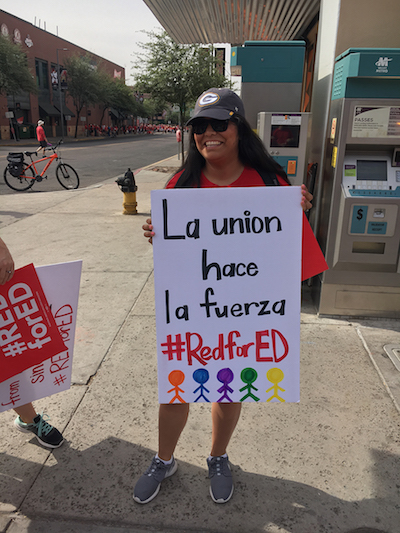Ten lessons from the teacher strikes
 Hundreds of thousands of educators from across the country walked out in 2018 and again in 2019—the first U.S. strike wave in generations. Socialists should celebrate this long-overdue return of the strike. But we also need to learn from these recent walkouts. What are the main lessons of this experience for DSA’s labor strategy? Here are 10 key takeaways:
Hundreds of thousands of educators from across the country walked out in 2018 and again in 2019—the first U.S. strike wave in generations. Socialists should celebrate this long-overdue return of the strike. But we also need to learn from these recent walkouts. What are the main lessons of this experience for DSA’s labor strategy? Here are 10 key takeaways:
1) Strikes work
Though electoral politics and community organizing are crucial avenues to build working-class power, the strike remains our greatest weapon as workers. By leaning on the structural leverage of workplace organizing, these walkouts won more in the span of a few weeks than was won through years of lobbying and rallying.
2) Fight for the common good
These strikes—led predominantly by female workers—succeeded because they proactively reached out to and won over parents, students, and the public at large. It was essential that educators fought not only for better pay and working conditions, but also for broader issues like more school funding, lower class sizes, more nurses and counselors, as well as anti-racist demands like an end to racial profiling in their schools.
3) Be prepared to break the law
Public-sector strikes are only legal in 13 states. From West Virginia to Arizona, educators kept on organizing despite the threats coming from politicians that they could be fined or lose their jobs. At moments of mass struggle, legality comes down to a relationship of forces.
4) The Democratic Party is not our friend
The mainstream media initially attempted to portray the educator upsurge as limited to “red states” run by Republicans. But the spread of the strikes to “blue states” like California has made it clear that Democratic politicians are no less responsible for policies of austerity, privatization, and corporate education “reform.” Only socialist insurgents like Bernie Sanders and Alexandria Ocasio-Cortez have consistently sided with strikers and their demands.
5) Deep organizing is key
The most successful strikes—particularly the January 2019 walkout in Los Angeles—confirm the “deep organizing” methods promoted by strategists like Jane McAlevey. Systematically identifying and developing organic leaders from the rank and file and building up to walkouts through a series of “structure tests” gave unions and their workplace shutdowns an unparalleled strength.
6) Strikes can organize the unorganized
These strikes show that the best way to organize unorganized workers is through successful, transformative actions. Thousands of striking educators joined unions, and tens of thousands more got actively involved for the first time. Though DSAers today should help initiate new workplace organizing where feasible, we need a transformed union movement to organize the millions.
7) Socialists and labor must reconnect
After decades of divorce from the labor movement, socialists played a key leadership role in many of these 2018-19 walkouts. DSA members and rank-and-file socialist teachers inspired by Bernie’s 2015-16 campaign were the key initiators of the strikes in West Virginia and Arizona. To deepen and expand this movement nationally, we need to re-root socialists in the working class and its organizations.
8) Be strategic
Good strategy is about setting priorities. Though tactical flexibility is essential, recent experience clearly shows that radical labor activists can generally make their maximum impact by working within existing unions in strategic industries like education and healthcare. As the “red state revolt” demonstrates, this is even true in Republican-dominated states with low union density and no collective bargaining for public sector workers.
9) It’s time to transform our unions
In “red states” like West Virginia and Arizona, rank-and-file educators successfully organized from below to push their unions to take strike action. But building lasting power will require doing what educators did in Chicago and Los Angeles: organizing rank-and-file caucuses to win the leadership of the union and transform it into a fighting body of and for an empowered rank and file. By participating in caucuses and networks like Labor Notes, DSAers can play a big role in rebuilding a powerful labor movement.
10) Make the rich pay
Corporate politicians always tell us there’s not enough to go around. These strikes directly challenged this scarcity narrative by showing that if we can force the government to start making the rich and corporations pay their fair share in taxes, there is more than enough funding to provide great public schools for every child in our districts and states. Working people deserve so much more—and we can turn the world upside down if we get organized.
 Democratic Socialists of America
Democratic Socialists of America